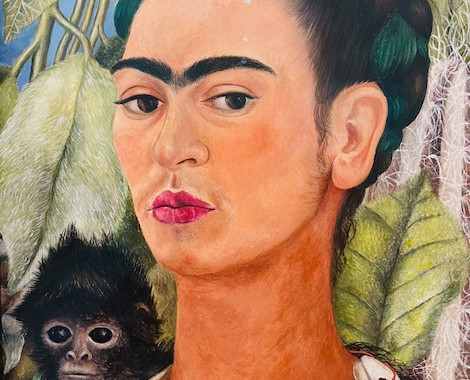Diego Rivera & Frida Kahlo and Jackson Pollock & Lee Krasner
- Gina Blitstein
- Mar 5, 2024
- 3 min read
Updated: Mar 3
We often hear about the artist’s temperament, and, yes, artists can be passionate people, and that passion extended to their relationships - for good & for ill (sometimes both at once!). Some of my website blogs this year (including this one for February at the time of writing - “the month for love”) are coming from this fascinating book by Veronica Kavass Artists in Love. My first blog in this series involves the relationships involving my two favorite artists - Jackson Pollock & Lee Krasner and Frida Kahlo & Diego Rivera. How were their relationships similar? How were they different? How (if in any way) did their relationships affect their art?
Both Frida Kahlo and Jackson Pollock married artists, and the artists they married, Diego Rivera and Lee Krasner, had much more established reputations in the art world than their spouses. Diego Rivera was a famous muralist and was in Paris with Pablo Picasso when Cubism began to dominate art. Lee Krasner had studied with Hans Hoffman in New York City and had at least a few commissions through the Works Progress Administration during the Great Depression.
Both relationships had their fair share of turmoil. Diego Rivera was unfaithful to Frida…A LOT - including with Frida’s sister, Christina. The cheating eventually became too much, they divorced for a time, but they eventually remarried when Frida’s health took a turn for the worse, and they realized that for all the pain and turmoil, they were better together than they were apart. Infidelity was not the main problem for Jackson and Lee until near the end of Jackson’s life. The major issues in their relationship were Jackson’s alcoholism, temper, and struggles with mental illness. He was in and out of analysis but was actually sober for around two years. Declines in sales, a “dry” creative period, and the feeling that Jackson’s art was becoming more of a commodity to be exploited and misunderstood contributed to the return to drinking, the worsening of temper that was well-known even when sober, and an affair with Ruth Klingman that drove Lee to Europe shortly before Jackson Pollock died after he crashed his convertible on the way back from a party; the crash also killed Ruth Klingman’s friend and seriously injured Ruth.
All four of them continued to be productive during their years together, but there are subtle and important differences. Because of Jackson’s problems, Lee was wife, mother, PR person, business manager, and any other practical tasks that needed to be done. Lee was doing these tasks and had to scale down her art to creating in a smaller upstairs room in their house in Springs, Long Island while Jackson was in the barn studio creating giant paintings that would proverbially set the art world on fire. Lee made the choice to sublimate her career to take care of Jackson’s needs. After Jackson’s death, she became a wise and smart caretaker of his estate and moved out to the barn to vastly expand her creative horizons. She lived a long full creative life until her death in June 1984. On the other hand, in spite of Diego Rivera’s problems in the fidelity area, he was Frida Kahlo’s biggest champion and supporter of her art. He was still creating his breath-taking murals but would talk up Frida and her small intimate paintings to anyone who would listen, arrange sales, etc. While Diego’s murals were giant in their undertaking and their messages about Mexican history, the world-wide plight of workers, etc., he was humbled by Frida’s self-portraits and small paintings that conveyed universal emotions of joy and pain experienced by all people regardless of gender, age, nationality, sexual orientation, etc. He was Frida’s partner in the most important and valuable way to her. He lived for only 3 more years after her death in 1954.
I hope you enjoyed reading this month’s blog and look forward to reading about other artists’ relationships!




















Commentaires